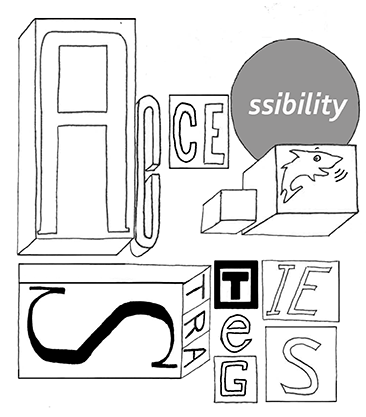Comics are a type of multimodal text in that they use more than one mode to transmit meaning to readers, and multimodal composition encourages readers and writers to challenge norms and beliefs about what makes a text; remixing compositions becomes easier. In this way, comics naturally challenge readers to consider what we think of as a text and why. For example, the accessibility guidelines that the World Wide Web Consortium advocates for web access are especially relevant to the teaching of comics because comics, like web documents, are a multimodal text; thus, these guidelines can serve as heuristics for comics lessons (Web Content Accessibilty Guidelines, 2008). Some relevant guidelines are:
- "Provide text alternatives" [in this case, audio as an alternative to image] (Guideline 1.1).
- Create content that can be altered or structured in different ways without losing meaning (Guideline 1.3).
- "Provide ways to help users navigate and determine where they are" (Guideline 2.4). [This can be achieved by having students create—and not just read—comics.]
These accessibility guidelines can be used as a framework for the equitable teaching of comics as a form of multimodal rhetoric. Let's look at some specific tools that can help with this.
Audio Comics
Audio comics are a useful tool to incorporate into course content as they provide another modality for students to understand comics. Major comic companies DC and Marvel have released audio libraries of popular titles using a software called Graphic Audio, a subscription service that allows for audio-only versions of their comic releases. This is beneficial to students with vision impairment but also challenges the classroom to consider what we view as a comic or even a text.
So-called soundtracks are becoming more common in the field of comics, particularly in light of the rise of digital editions. Some are adaptations, while others are direct transcriptions.
Here's a clip from Ms. Marvel, the story of high school student turned superhero Kamala Khan, to illustrate (Marvel Entertainment, 2015).
Unlike some other comics, Ms. Marvel is a direct translation of the print book, which would serve well for differentiated instruction or an activity that allowed students to choose their medium of comic. These tools could create conversation on how audio adds to multimodality. For example, students might discuss the ways an audio comic might differ from a traditional single-issue comic. While audio is a feature of multimodality, it's sometimes not used or studied as much as visual, particularly in the field of comics, yet sound offers rich opportunities for discussion of rhetorical moves and is more inclusive to students with vision impairment. It can also be captioned for students with hearing impairment.
Accessible Comics
Audio comics do not typically make use of image, and comic publishers have lagged in making not only text but also image transcription available for readers. Some organizations have tried to bridge this gap. Operating until 2018, an important collective devoted to accessible comics, specifically for the visually impaired—Comics Empower—developed original characters who embody diversity and address disability through the creation of alternate text comics that describe images and panel transitions. The organization described on its website its mission as one that fosters inclusion through the writing of its story plots: "The good guys will win. Of course they will. There may be hard times in-between, but the good guys will win. That's how empowerment works" ("Empower Your Kids," n.d.). The organization's founder noted that, although the characters may have superpowers, they will never develop powers that help them magically overcome their disability, as that's not how it works for kids (the organization's intended audience) in real life. Although this organization no longer operates, it shows the growing market for comics in a variety of mediums.
While no other company or organization has fulfilled the unique role of Comics Empower, there are websites that make comic scripts available. The blog Comics Experience now features an archive of comic scripts, which can foster conversation for all students about differences in visual and print medium. Even movie and television adaptions of comics have—slowly—begun to add image descriptions to audio transcription. The streaming service Netflix has audio descriptions available for the entirety of its Marvel series, including Daredevil, Luke Cage, and Jessica Jones, a hopeful sign that more visual art will provide accessible options for readers and viewers. A list of available titles has been cataloged by the Audio Description Project, a project of the American Council of the Blind.
Opportunities for Alt Text
In terms of traditional print comics, some very popular graphic novels, such as Art Spiegelman's Maus and Marjanne Satrapi's Persepolis, are available in braille and large print. Students may also be interested in viewing Philip Meyer's Life, a comic created in braille text. Most braille materials can be found using the Louis Database of Accessible Materials, and can be obtained via library systems. Still, there is a greater need for comics to provide alternate text for visual images, a need that can be easily addressed due to the rise of digital and web comics. Programs that allow readers to digitally store and collect comics, such as Simple Comics or Amazon's Comixology, might prove helpful for students, particularly those programs that are set to read metadata. Paired with screen readers, digital comics have the potential to adapt graphic literature into a more accessible form, although the comic author and publisher still must include those image descriptions for readers.









